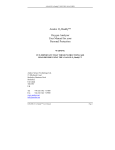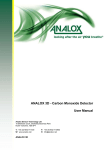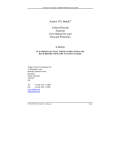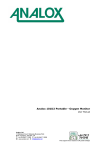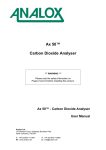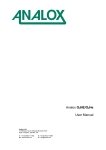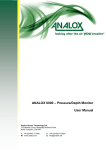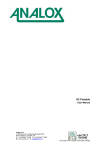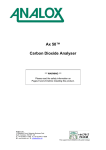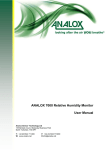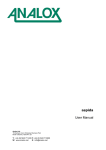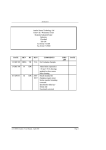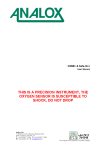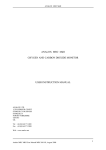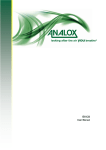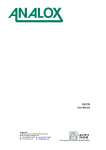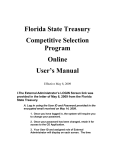Download QPD Personal O2 Monitor - Advanced Gas Solutions
Transcript
QPD Personal O2 Monitor User Manual Analox Ltd. 15 Ellerbeck Court, Stokesley Business Park North Yorkshire, TS9 5PT, UK T: +44 (0)1642 711400 F: +44 (0)1642 713900 W: www.analox.net E: [email protected] QPD Personal O2 Monitor User Manual List of Contents 1 2 3 4 5 Introduction..........................................................................................................................1 1.1 Description.....................................................................................................................1 1.2 Regulatory conformity....................................................................................................1 1.3 Electrochemical sensors (oxygen).................................................................................1 Alarms .................................................................................................................................3 2.1 Alarm Settings ...............................................................................................................3 Operating.............................................................................................................................4 3.1 Operating conditions......................................................................................................4 3.2 Operating the QPD ........................................................................................................4 3.3 Calibration, servicing and maintenance ........................................................................5 QPD indications...................................................................................................................6 Disposal...............................................................................................................................7 5.1 WEEE statement ...........................................................................................................7 Document Ref: P0129-800-00 - May 2012 Page 1 QPD Personal O2 Monitor User Manual 1 Introduction 1.1 Description 1.1.1 QPD is a personal oxygen monitor which continuously monitors the concentration of oxygen in the air to which its sensor is exposed. 1.1.2 It provides a large visual LCD display of the monitored % oxygen concentration except when an alarm state (low oxygen alarm or high oxygen alarm) is indicated when the LCD display reads the default indication of HI or LO as appropriate. 1.2 Regulatory conformity Analox Ltd. is accredited to ISO 9001:2000 This product is CE certified (EMC;2004/108/EC) Analox Ltd. complies with RoSH and REACH directives All Analox Ltd. products conform to the WEEE directive (2002/96/EC) 1.3 Electrochemical sensors (oxygen) Electrochemical sensors contain toxic compounds. Under normal conditions the sensor will be safely sealed. To prevent leakage, the unit must not be exposed to temperatures outside the specified range, or be exposed to organic vapours, which may cause physical damage to the body of the sensor. The unit must not be stored in areas containing organic solvents or in flammable liquid stores. When the life of the sensor has expired or it is leaking or otherwise damaged it must be disposed of safely in accordance with local regulations. The oxygen cell contains caustic electrolyte (potassium hydroxide). In the event of an accident, use the following first aid procedures. Body Part Skin Ingestion Effect First Aid Procedures Contact could result in a chemical burn. Immediately flush the skin thoroughly with water for at least 15 minutes. Persons with pre-existing skin disorders may be more susceptible to the effects of the substance. Remove contaminated clothing and wash before re-use. Corrosive. May cause sore throat, abdominal pain, nausea, and severe burns of the mouth, throat, and stomach, and may be fatal. Obtain medical advice if continued irritation. If swallowed DO NOT INDUCE VOMITING. Wash out mouth thoroughly with water and give plenty of water to drink. Obtain medical advice immediately Document Ref: P0129-800-00 - May 2012 Page 1 QPD Personal O2 Monitor User Manual Eye Persons with pre-existing eye problems may be more susceptible to the effects of the substance. Irrigate thoroughly with water for at least 15 minutes. Obtain medical advice immediately. Corrosive. May cause redness, pain, blurred vision, and eye burns. Inhalation Contact can result in the permanent loss of sight. Persons with pre-existing impaired respiratory function may be more susceptible to the effects of the substance. Remove to fresh air. Rest and keep warm. Obtain medical advice if applicable. Inhalation is not an expected hazard unless heated to high temperatures. Mist or vapour inhalation can cause irritation to the nose, throat, and upper respiratory tract. Table 1 - Electrochemical sensor first aid procedures Should leakage of any electrolyte occur as a result of misuse, incorrect operation, manufacturing error, physical damage, etc. then wear protective gloves when cleaning any spills. Should electrolyte contact skin then the affected area should be washed thoroughly with copious water and medical advice sought if there has been any contact with the eyes or mouth. If connected to any electrical equipment, the sensor should be immediately removed. Document Ref: P0129-800-00 - May 2012 Page 2 QPD Personal O2 Monitor User Manual 2 Alarms 2.1 Alarm Settings 2.1.1 The normal concentration of oxygen in air is approximately 20.8%.The monitor is factory pre-set with four alarms, a ‘LOW’ alarm of 19% and a ‘CRITICALLY LOW’ alarm of 18% oxygen and a corresponding ‘HIGH’ & CRITICALLY HIGH’ of 22.5% and 24% oxygen in the surrounding air. 2.1.2 Should the monitored oxygen concentration become lower than the pre-set low oxygen alarm level of 19% or higher than the pre-set high oxygen alarm level of 22.5% or should the voltage of the battery within the unit fall below a pre-set threshold, both visual, audible and vibration warnings are activated. (Other settings are available on request.) Document Ref: P0129-800-00 - May 2012 Page 3 QPD Personal O2 Monitor User Manual 3 Operating 3.1 Operating conditions Operating and storage temperature 0 to 30 ºC Short time excursion temperature -15 to +45 ºC Operating relative humidity 0 to 99% RH (non-condensing) Operating pressure range Atmospheric ± 10% T90 response time Typically 17 seconds 3.1.1 Important note: If unit is taken from a cold atmosphere into a warm humid atmosphere it is possible that condensation of water may temporarily block the oxygen sensor capillary and cause the unit to indicate a low oxygen alarm state. 3.1.2 The unit should immediately be taken out of service and be placed in a warm dry atmosphere until the condensation has cleared and the unit works correctly again. 3.2 Operating the QPD 3.2.1 The QPD is designed to operate continuously for 2 years. The unit can be serviced by Analox every 2 years and may be returned by post for this service, if required. Service agreements are available upon request. There is no ON / OFF switch so the unit can not be left off accidentally. 3.2.2 Normally the monitored concentration of oxygen lies between the pre-set low oxygen and the high oxygen alarm levels and in this situation there should be no alarm lights and no audible alarm. The LCD on the front face of the unit should indicate the monitored concentration of oxygen. 3.2.3 Before use always give the unit an alarm test. Exhale gently into the sensor orifice at the left hand side of the front face of the unit and the low oxygen LED should start to flash and the audible alarm to bleep within 20 seconds. When the orifice is exposed to fresh air following the test the unit should return to the non-alarm state within a few seconds. Care should be taken to blow gently in order to ensure that excess moisture does not enter the sensor orifice. 3.2.4 If the ‘LOW ALARM’ indications are not activated by this test, optimise the unit in fresh air as described in the ‘Calibration’ section below. QPD oxygen monitor is not to be used in classified flammable areas Document Ref: P0129-800-00 - May 2012 Page 4 QPD Personal O2 Monitor User Manual 3.3 Calibration, servicing and maintenance 3.3.1 The QPD unit is tested and calibrated with certified test gases before despatch but sensor optimisation in fresh air should be carried out regularly during the two year sensor life of the unit. 3.3.2 Analox Ltd recommends that the user performs a fresh air calibration at least once a month, under normal ambient conditions. Press the two buttons on either side of the unit simultaneously and hold until ‘CAL’ appears on the display (around 5 seconds). Release the buttons and the oxygen concentration will optimise to ambient conditions of 20.8%. 3.3.3 After 2 years, the unit may be returned to Analox Ltd for calibration with certified test gases and to obtain a calibration certificate. 3.3.4 The QPD contains an oxygen detecting sensor and a special battery pack which allow the unit to operate continuously for 2 years under normal ambient (non-alarm) conditions. If the unit has indicated an alarm condition for long periods of time, the battery life will be shortened. 3.3.5 If the audible alarm gives a constant tone, the unit should be taken out of service immediately and returned for servicing. If the user wishes to silence the audible alarm for the purpose of returning to Analox, they may open the unit (by removing four corner self tapping screws. The battery can then be carefully unplugged from the unit). Never use a battery pack in this unit other than one supplied by Analox Document Ref: P0129-800-00 - May 2012 Page 5 QPD Personal O2 Monitor User Manual 4 QPD indications Display Normal operation O2 concentration e.g. 20.8% Alarms ‘HI’ ‘HI’ ‘LO’ ‘LO’ Calibration ‘CAL’ (Flashing) ‘CAL’ ‘SEN’ Audible LED Meaning None No Normal operation. O2 concentration is displayed 2 short beeps (mid) 5 short beeps (high) 2 short beeps (mid) 5 short beeps (high) Yes Warning high O2 Critical high O2 Warning low O2 Critical low O2 No Calibration is required before use Calibration is complete Unit cannot be calibrated. Possible causes: • Reference O2 concentration too low or high • End of sensor life • Faulty sensor • Sensor disconnected No Low battery. Unit no longer provides protection. Possible causes: • End of battery life • Faulty battery Measured O2 concentration is <5%. This would indicate a fatal concentration on a correctly calibrated working sensor. Possible causes: • Sensor at end of life • Incorrect calibration • Faulty sensor Measured O2 concentration is >30%. This could indicate a potentially dangerous concentration which is outside the measurement range of the sensor. Possible causes: • Incorrect calibration • Faulty or damaged sensor Sensor voltage is too low. Possible causes: • Sensor at end of life • Sensor disconnected • Faulty sensor Sensor voltage is too high. Possible causes: Faulty or damages sensor 1 long beep (low) 1 short beep (high) 1 long beep (low) Errors ‘bAt’ ‘E 1’ ‘E 2’ 1 long beep (low) ‘E 3’ ‘E 4’ After battery is connected ‘t 1’ to ‘t 9’ Various ‘SERVICE’ Various Document Ref: P0129-800-00 - May 2012 Page 6 N.B. These indications can also arise from incorrect calibration Self-test. Indications can be ignored. After test has finished, unit will require calibration before use Service/Calibration due QPD Personal O2 Monitor User Manual 5 5.1 Disposal WEEE statement According to WEEE regulation this electronic product can not be placed in household, waste bins. Please check local regulations for information on the disposal of electronic products in your area. Document Ref: P0129-800-00 - May 2012 Page 7













